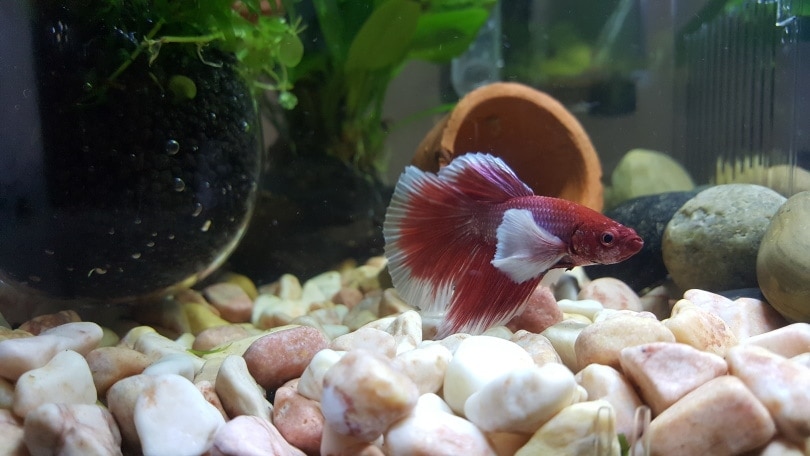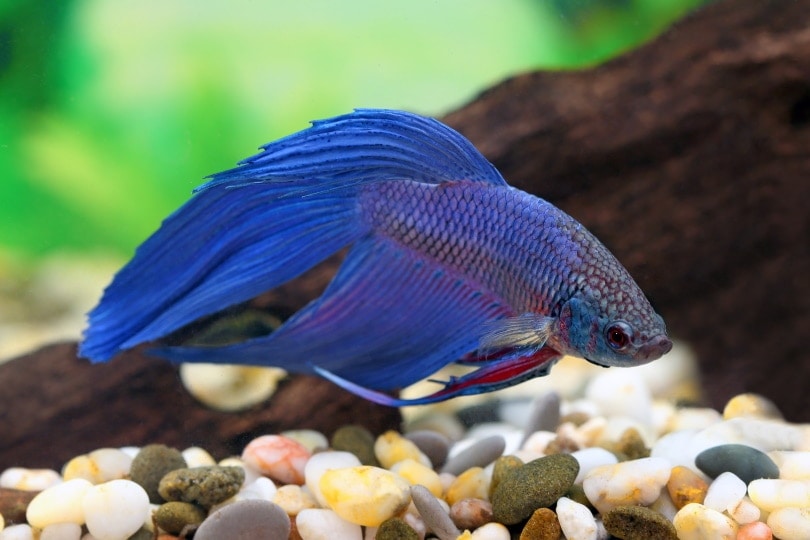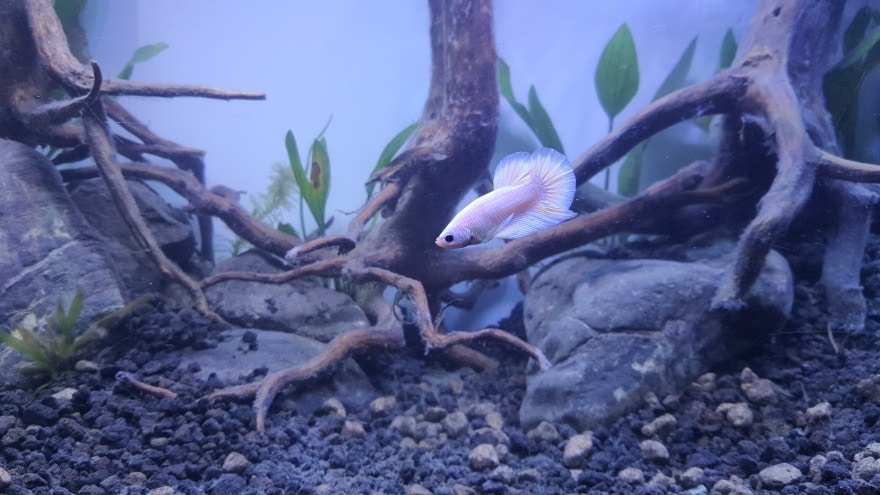25 Types of Betta Fish: Breeds, Patterns, Colors & Tails (with Pictures)
Updated on
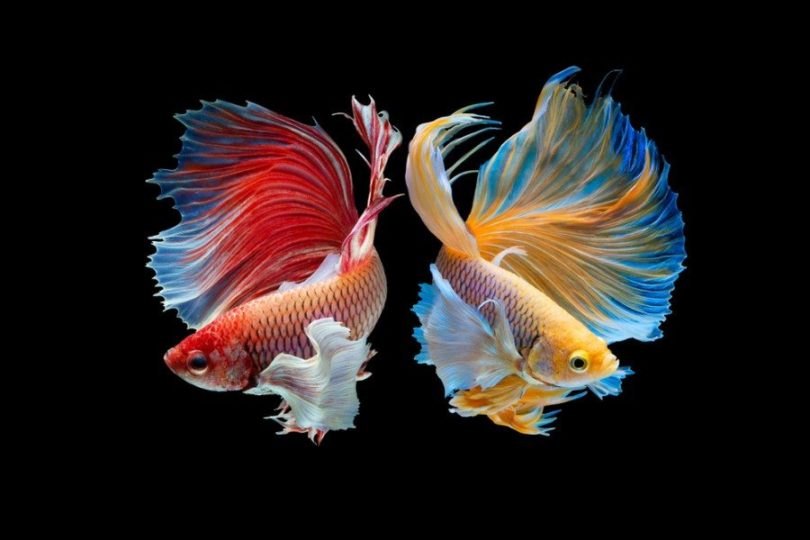
Click to Skip Ahead
One of the most popular colorful and tropical fish is the Betta or Siamese fighter fish. Betta fish have been kept as pets for centuries, making them one of the oldest domesticated fish aside from goldfish. Due to years of selective breeding, many Betta fish colors, patterns, and tail types have been developed by breeders. Many breeders take pride in creating new varieties of Betta fish in the hopes of improving the fish’s qualities and fascinating appearances.
This article will focus on the various colors, patterns, and tail types that Betta fish can be found in. As a popular fish that is regularly bred, there are always new types of Betta fish popping up in the hobby.

About Betta Fish Breeds
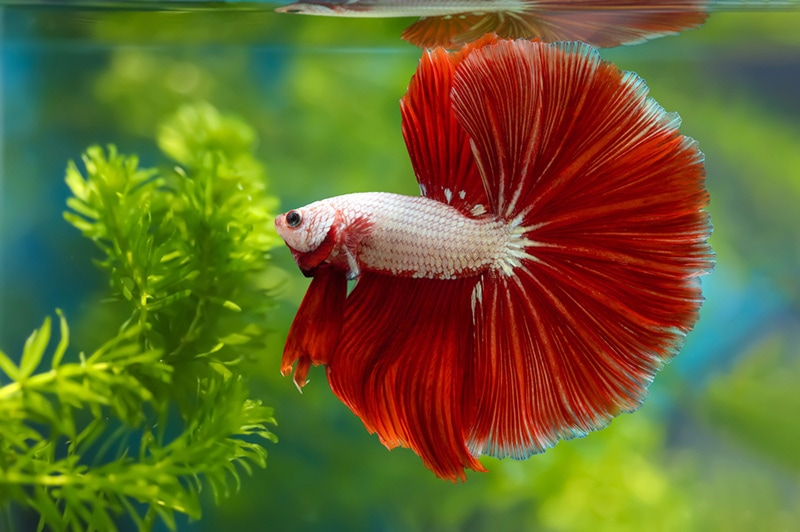
Betta fish doesn’t just refer to a single species, but rather over 70 different ones. However, Betta splenden is the species that are often kept as pets. This is also the same species that have been selectively bred to produce hundreds of different varieties. All Betta fish are freshwater anabantoids, which are fish that can breathe surface oxygen using a labyrinth organ. Also, most Betta fish are between 2 to 3 inches in size, with females having a larger body than males. However, the male Betta fish can be found in most fin, patterns, and color types.
Regardless of their color or fins, all domesticated Bettas have relatively similar care. Below is the basic information regarding pet Betta fish.
| Common name: | Betta fish |
| Origin: | Thailand |
| Water conditions: | Freshwater, tropical (heated) |
| Temperature: | 72 to 85 degrees Fahrenheit |
| Diet: | Carnivore |
| Minimum tank size: | 5 gallons for heavy-finned, up to 10 for female or short-finned varieties. |
| Compatibility: | Male Betta fish are solitary and should never be kept in the same tank. |

Types of Betta Fish Tails
Betta fish are widely known for having a variety of different types of tails. The type of tails and fins that the Betta fish has may affect how they swim. The larger or heavier-finned varieties of Bettas may be slow-moving in comparison to the short-tailed Bettas. Furthermore, male Bettas have the most tail variations. The female Bettas are usually a duller color than the males, and their fins are not as long and prominent in comparison to the rest of their bodies.
It’s common for Bettas to be named after their appearance or caudal fin shape, so their name typically gives you insight into how the fish is expected to look.
1. Crowntail Betta Fish
Crowntail Bettas have distinctively shaped fins that earn them their name. These caudal fins look like webbing with long rays at the ends. The caudal fin flares out from the Betta fish’s body and can vary in color. Due to the delicacy of a Crowntail’s fin, they shouldn’t be kept in an aquarium with sharp decorations or other aggressive fish. Crowntails usually don’t have much difficulty swimming in a larger aquarium as long as the water current isn’t too strong.
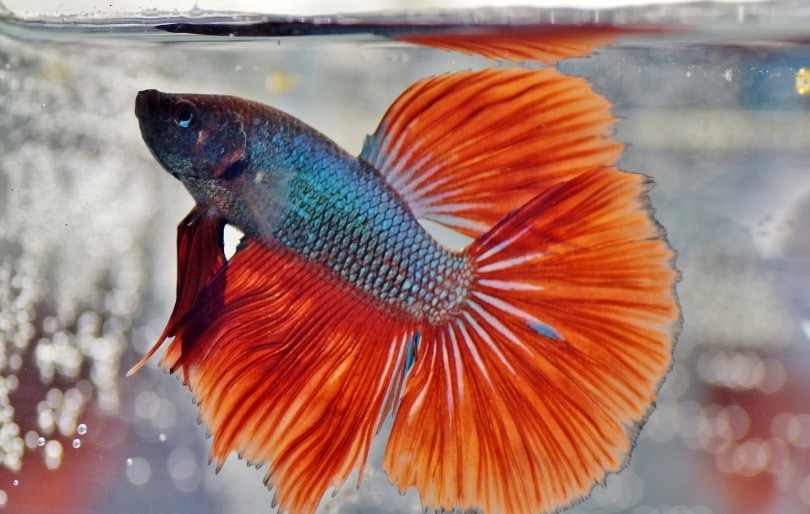
2. Veiltail Betta Fish
One of the more readily available Betta fish has a veiltail. A Veiltail Betta fish has a simple yet elegant caudal fin that makes them better swimmers than many other Betta varieties. These Bettas have long dorsal and anal fins, with a narrow caudal fin. Their fins generally aren’t very heavy or dragging in the water, so Veiltail Bettas can be good swimmers. Furthermore, Veiltail Bettas can be found in various colors and patterns, but turquoise is more common.
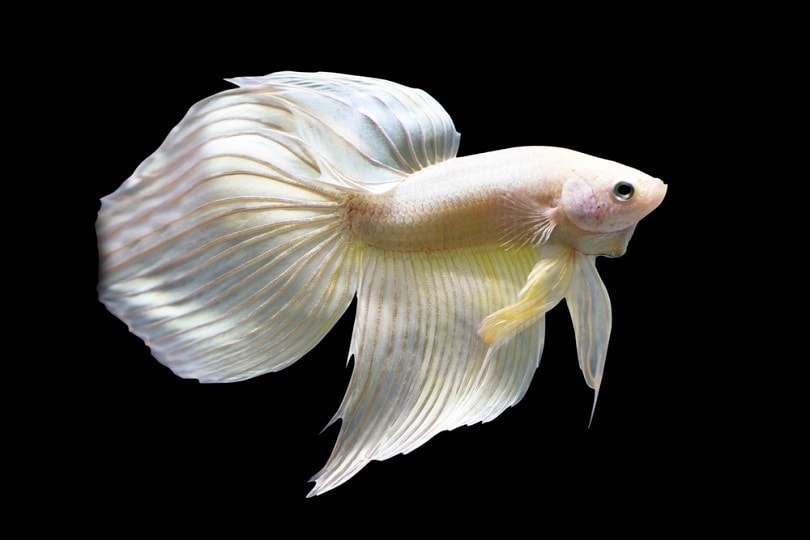
3. Halfmoon Betta Fish
A popular variety of Betta fish is those with halfmoon tails. Their fins are long and flowy, usually double the size of their bodies. Halfmoon Bettas can also be found in a variety of colors and patterns that make them appealing to many hobbyists.
Due to the Halfmoon Betta’s heavy fins, they may have difficulty swimming in very large tanks or tanks with fast-flowing filters. Halfmoon Bettas will appreciate having plenty of soft leaves and surfaces to rest on in between swimming.
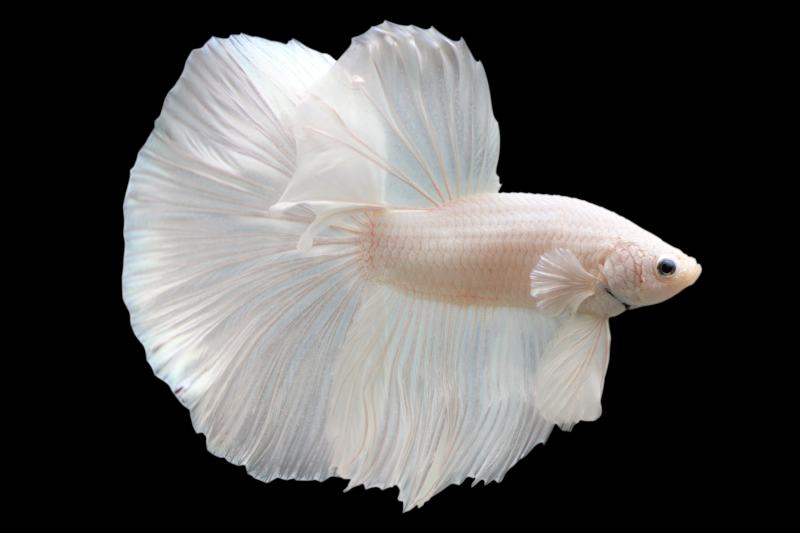
4. Plakat Betta Fish
Plakat Betta fish look quite similar to their wild counterparts in terms of their fins. A Plakat Betta has short and simple fins that make them efficient swimmers. Their fins allow them to swim more easily regardless of how strong the filtration system is. However, Betta fish in general still don’t prefer to have a strong current in their aquarium.
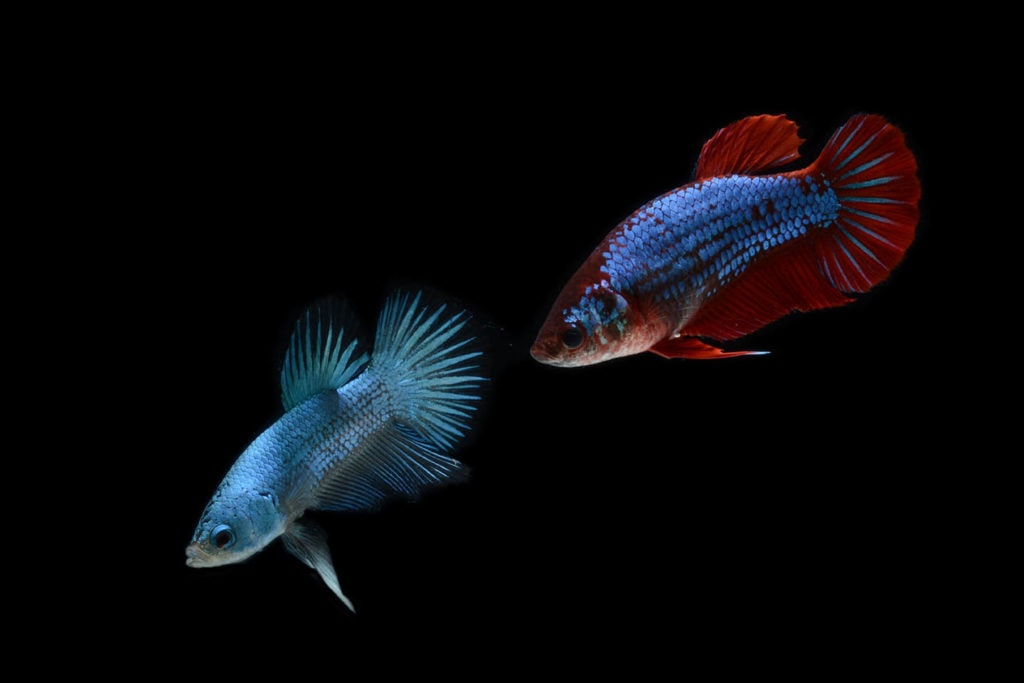
5. Rosetail Betta Fish
One of the most beautiful yet heavy-finned Betta fish is Rosetails. These Bettas have extremely long fins that frame most of their bodies. When all their fins are upright as the Betta is flaring, the fins can form the shape of flower leaves, hence their name. As a type of heavily finned Betta fish, they require plenty of soft resting places in the aquarium with a low-flowing filter. You might find that Rosetail Bettas aren’t as active as the others since their fins weigh them down.
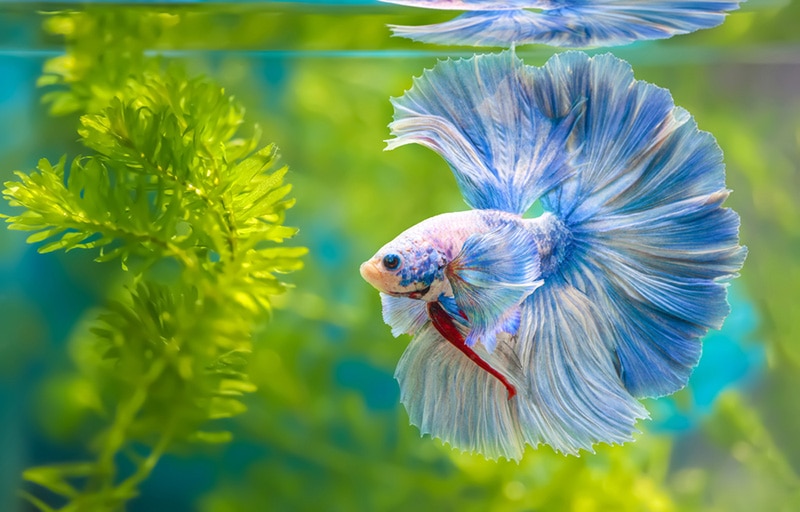
6. Elephant Ear Betta Fish
Aside from their interesting name, these Bettas also have a fairly unique appearance. Elephant-eared Bettas have very large pectoral fins that stand out on their bodies. These Bettas can have various tail shapes, and the large fan-shaped pectoral fins look spectacular when paired with heavy-finned Betta fishes. Even if the Elephant-eared Betta has a short caudal fin, their large pectoral fins don’t make them very agile or fast swimmers.
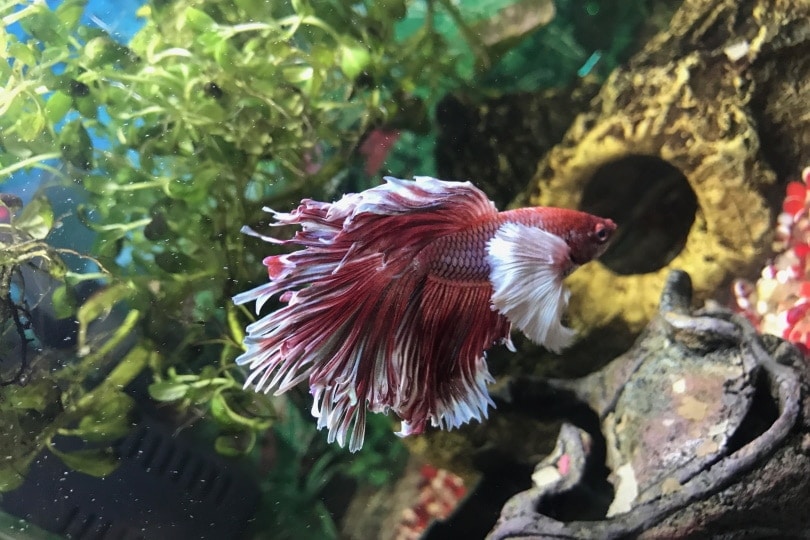
7. Giant Betta Fish
The Giant Betta fish, scientifically known as B. anabatoides is one of the larger-growing Bettas. Giant Betta fish can grow up to 5 inches in size, although they typically grow up to 4 inches. This is a few inches bigger than the B. splendens, the most commonly kept Betta fish. Giant Betta fish are fairly uncommon in some areas and aren’t found in as diverse colors, patterns, and fin types as the B. splendens.
Due to the Giant Betta fish’s expected size, they require much larger tanks than other Bettas. Most giant Betta fish do well in a 10-to-20-gallon tank, although they can live in slightly larger ones.

8. King Betta Fish
If you come across a Betta labeled as a “King”, it is just a fancy way of labeling a Betta that is slightly larger than average, but not as big as a Giant Betta fish. They have the scientific name B. splendens regen and can reach a size of 3 to 3.5 inches. They can be found in similar colors and fin types as other Betta fish.
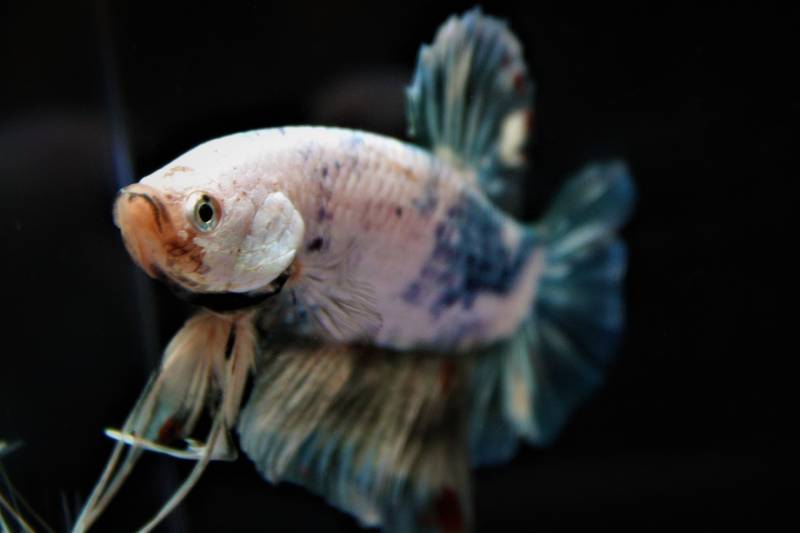
9. Double Tail Betta Fish
The Double-tail Betta fish looks similar to the Halfmoon, but the caudal fin looks as if it is separated into two fins instead. In some cases, the bottom caudal fin can be shaped like a heart. Double-tail Bettas can be found in various colors and patterns, although the greenish-black coloration is particularly striking. Double-tailed Bettas usually swim well, although the fins can become heavy at times if they are long.
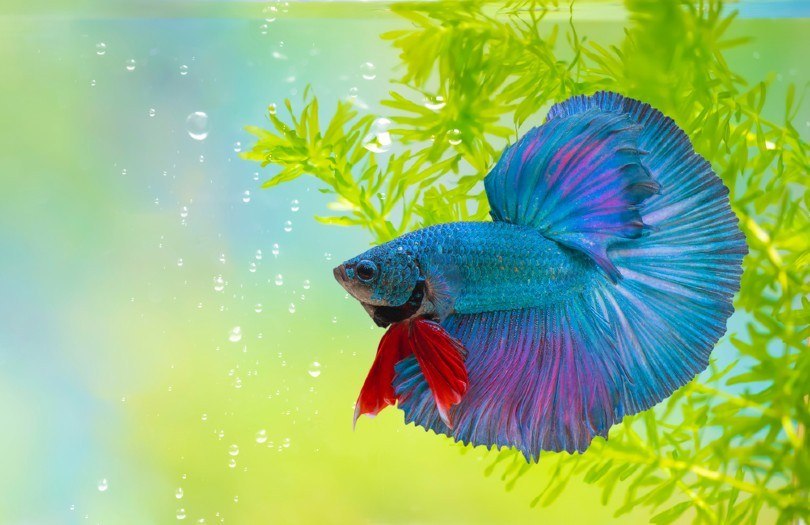
10. Wild-Type Betta Fish
Wild-type Bettas are not as common in the hobby, and they occur in their natural wild form. They are generally greenish and have an elongated body shape. Thanks to selective breeding, you can also find Wild-type Bettas in other iridescent colors like red, yellow, and blue.
Most Wild-type Bettas are excellent swimmers and can even be fast and agile in the water. Their size varies from 2 to 4.5 inches in size, and as they have short fins, they require larger tanks than other types of Betta fish. With plenty of hiding places from live plants, Wild-type Bettas can thrive in large tanks.
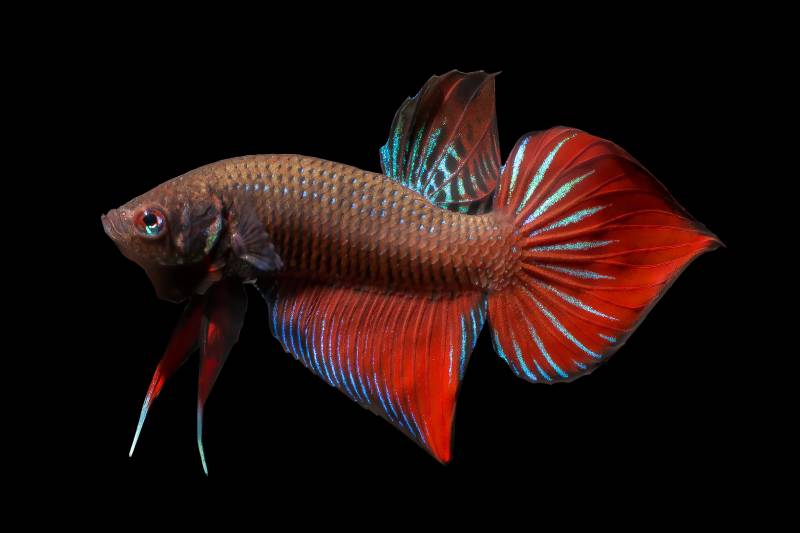
11. Combtail Betta Fish
The Combtail Betta is often confused with the Crowntail, as their fins can look similar at first. This is because both of these fish have threadlike fins that look like webbing. With Combtail Bettas, the rays are longer and take up more space than the webbing on the fish’s fins. The combtail’s care and swimming ability are relatively the same as the Crowntail Betta fish, and there’s not much of a difference aside from the length of the rays.
12. Delta Betta Fish
You can spot a Delta Betta fish by looking at their dorsal fins. A Delta-tailed Betta fish will have a pointier dorsal fin than other types of Bettas. Their caudal fin becomes narrower towards their body, and fans out at the ends. Most Delta-tailed Bettas swim perfectly fine, and their tails aren’t overly long and heavy.
There is another variation known as the “Super Delta” Betta fish. These Bettas have a caudal fin that resembles both a Halfmoon and Delta Betta fish. The dorsal and tail fins are very long and prominent on the fish, and their caudal fin has no crowning or fraying.
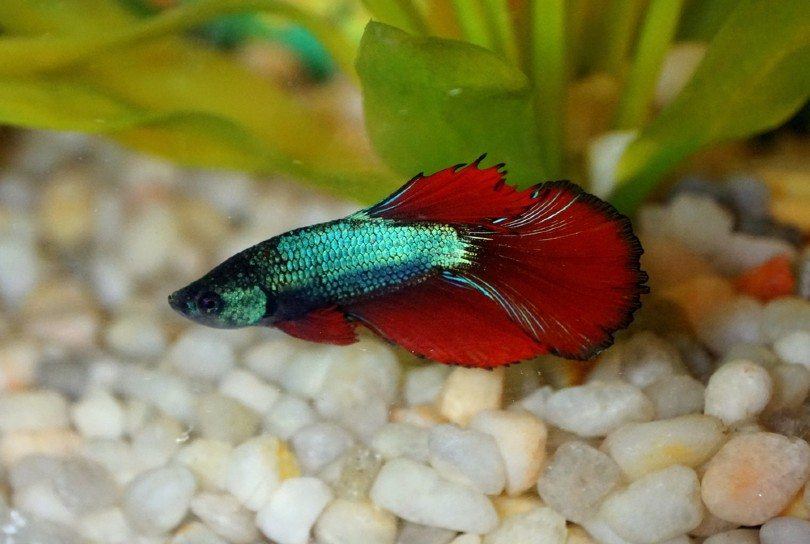
13. Half Sun Betta Fish
If a Betta fish has slight crowning at the ends of the fins that are not significant enough to be a Combtail or Crowntail, it is likely a Half-sun Betta. These Betta fish have a half-moon tail with a small section of the tail end showing crowning. They are often overlooked because the crowning can appear as fraying or damage to the tail which isn’t appealing for many Betta fish keepers. Half-sun Bettas can also be found in a variety of colors and patterns that might make up for their unusual fins.
14. Feathertail Betta Fish
One of the more striking and rarer Bettas would be the Feathertail variety. These Bettas have uneven and ruffled caudal, anal, and dorsal fins that give them an interesting appearance. Their fins make them easy to identify, but their fins are not for everyone. Some hobbyists don’t like the messy and ruffled appearance these fins have, while others find this variety to be interesting. When the fins are flared, the fins can appear as half of a sideways flower.

15. Fan Tail Betta Fish
Fan or Round-tailed Betta fish have simple fins with rounded caudal edges. The dorsal and ventral fins can either be long or short, and this can affect their swimming. Most Fantail Betta fish are excellent and strong swimmers. Their rounded caudal fins propel them through the water and don’t weigh them down much.
Like other Bettas, the Fantail Betta can be found in several colors and patterns. Blues, yellows, and white are usually the most common colors in this fish, although they can have multiple colors too.

16. Spade Tail Betta Fish
The Spade Tail Betta fish has uniquely shaped fins that make them stand out. You can easily identify a Spade Tail Betta by its round and slightly pointed caudal fins. Their anal fins are usually long and flowy, although they can also be shorter and end at a defined point. Spade Tail Bettas never disappoint when it comes to their vibrant and interesting color combinations.
As a short-finned variety, Spade Tail Bettas make good swimmers and do well in small to medium-sized tanks.
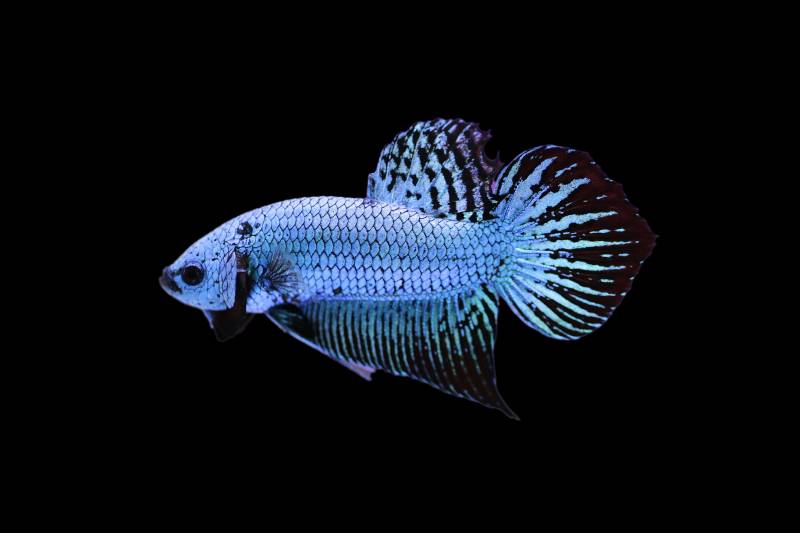

What Types of Colors Do Betta Fish Come In?
Bettas are often described as the jewels of the aquarium and for good reasons. These freshwater fish can be found in many different colors and combinations. Some of the colors can vary in richness and in some cases, a mixture of colors can result in some unusual yet stunning colored Betta fish.
- Orange
- Gold
- Red
- White
- Yellow
- Black
- Green
- Emerald
- Blue
- Pink
- Grey
- Violet
- Brown
- Copper
- Pastel or opaque
The most common colors found in Betta fish include reds, blues, and whites. While the rarer colors include pastel pinks, yellow, orange, gold, and copper. Wild-type Betta fish generally have dull green, grey, or brown colorations and are not as vibrantly colored as domesticated Betta fish.
Although black is usually a common color in some other fish species, true black Betta fish are rare. These black Bettas are known as Melano Bettas, and they look striking in lighter-themed aquariums. If the Betta isn’t a true black fish, the black coloration usually develops a blue or grey tint. However, these Bettas are equally appealing.
So far, there is no real evidence that an albino Betta fish exists, but there might be a rare case of albino Bettas hatching in a clutch. However, you do get Bettas with a white or pearl coloration. These types of Bettas are often misidentified as albino Bettas, but they simply just have a platinum-white coloration. In most cases, white Betta fish may have a slightly pink or pearled appearance in direct lighting.

Types Of Betta Fish Patterns and Color Combinations
Bettas have been bred to develop several patterns too. However, solid-colored Bettas are pretty common and prized by Betta fish keepers. Let’s take a look below at the different patterns that Betta fish are available in.
1. Mustard Gas
The term “mustard gas” is used to describe a Betta fish pattern or dark yellow (mustard), and blue Betta fish. They are considered rare bi-colored Betta fish that were developed in the late 1990s by Jude AI. This pattern took over a decade to perfect in Betta fish and plenty of experimentation. Mustard gas Bettas generally have blue- and yellow-colored fins, although the blue can sometimes be replaced by brownish-blue colorations.
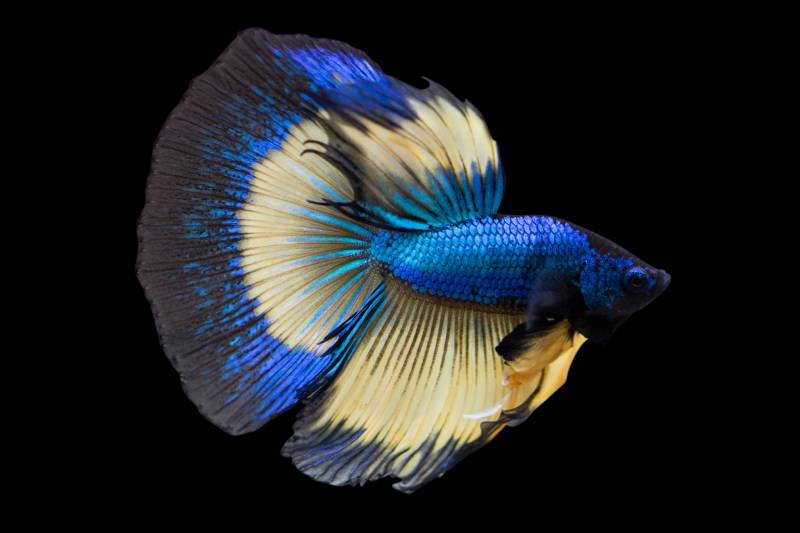
2. Marble
Koi or marbling in Betta fish refers to a combination of colors to resemble that of a koi fish. The colors don’t follow a particular pattern or structure, and a marbled Betta generally has three colors. Two of these colors will be spotted, blotchy, or patchy on the fish’s main body coloration. These are probably the most striking and vibrantly colored Bettas you can get.
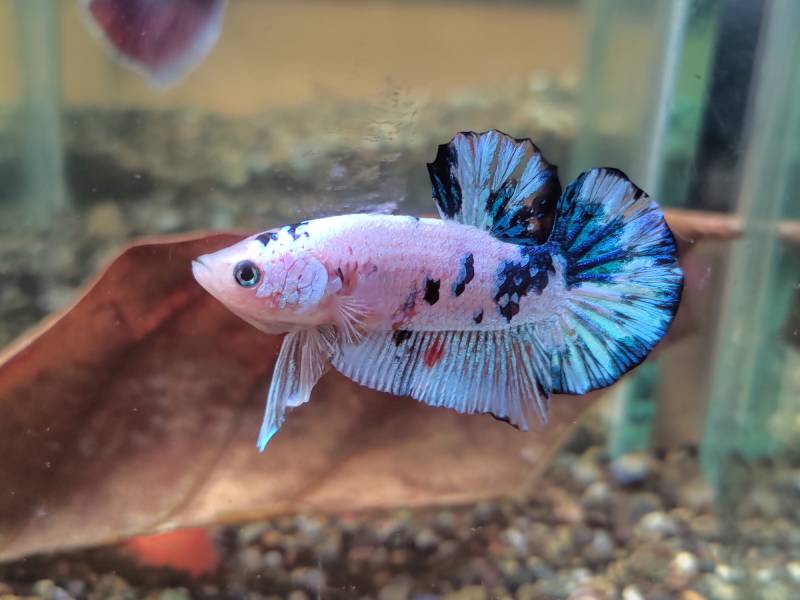
3. Bi-Colored
Bi-colored refers to any Betta with two colors. The colors can be distinct and do not overlap with each other, but these colors can sometimes be uneven.
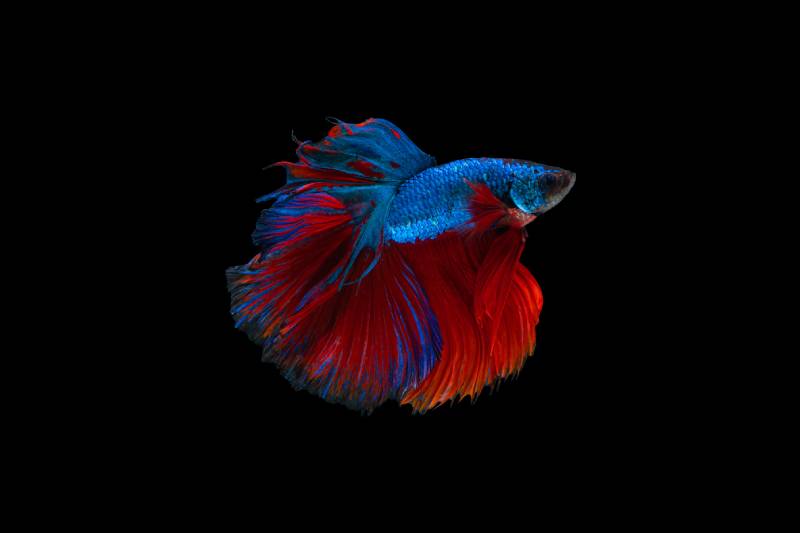
4. Tri-Colored
Any Bettas with more than three colors on their bodies. They are often called multi-colored Bettas and look quite striking in aquariums. The colors are usually uneven and create fascinating color combinations in Bettas.
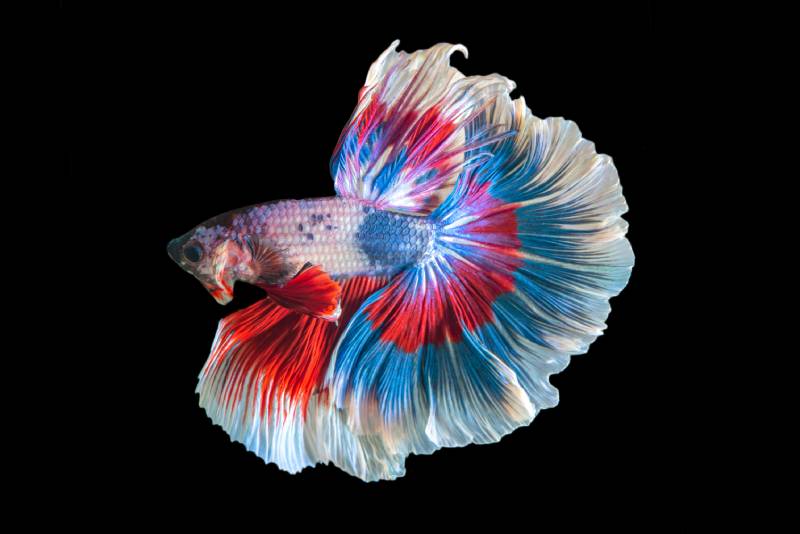
5. Piebald
Piebald Bettas generally have a light-colored face that is white or fleshy. The rest of their body is generally darker.
6. Butterfly
A highly sought-out Betta fish is the butterfly Betta. These Bettas typically have long fins with the ends of them being a certain color, and the rest a separate one. In some cases, the caudal fin’s base color can “leach” into the rest of the fin’s coloration. Depending on the quality, some butterfly Bettas can have distinct color differences between their bodies, the base of their fins, and the ends of their fins. Common color combinations in butterfly Bettas include red, white, and blue.
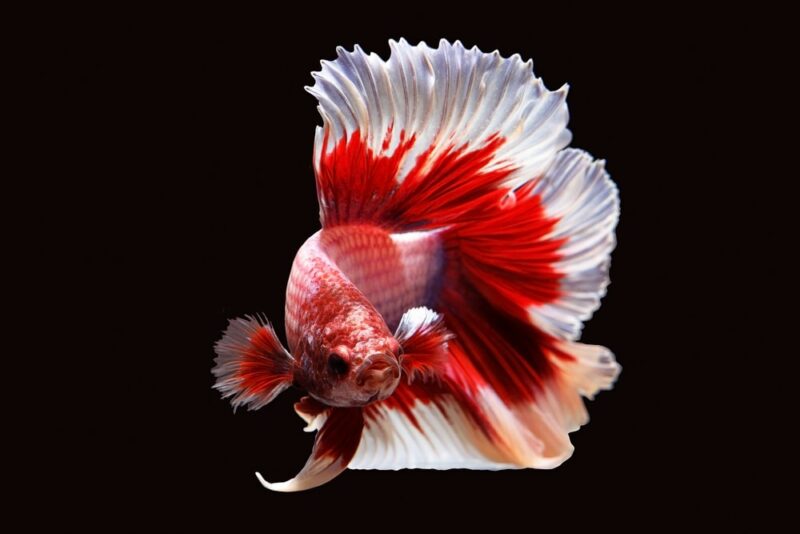
7. Cambodian
Cambodian Bettas generally have a light, solid body color, and the rest of their fins are another contrasting color. They are considered bi-colored Bettas, and their light bodies are believed to be caused by a recessive gene. Sometimes, older Cambodian Bettas can develop black spotting. However, breeders are unsure of how this irregular spotting occurs, although it is possibly inherited.
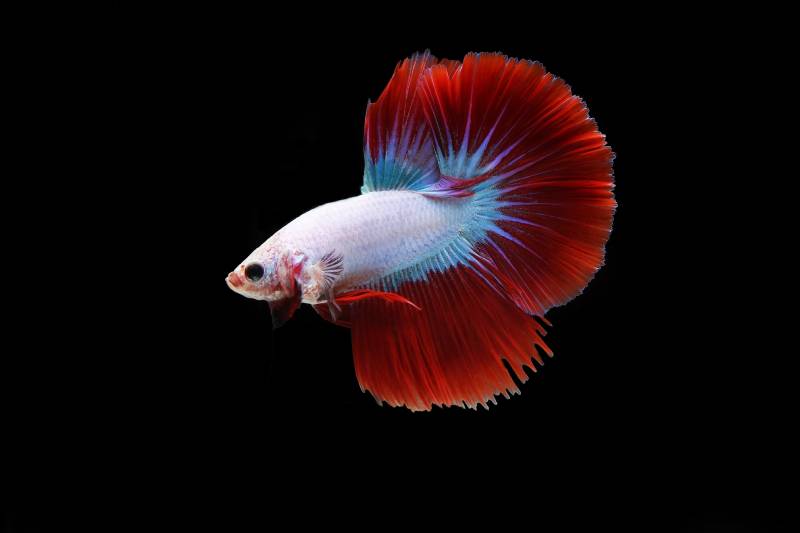
8. Dragon scale
Dragon scale Bettas are elegant and striking, and the term “dragon scale” is used to describe the thick, white scales that overlap their bodies. This makes the scales of the fish more prominent than standard Bettas due to the dragon gene.
This variation of Betta fish is the result of crossing different Betta species together, and they are quite uncommon to come across. If you want a true dragon scale Betta fish, finding a good and reputable breeder that specializes in dragon scale Bettas is recommended.
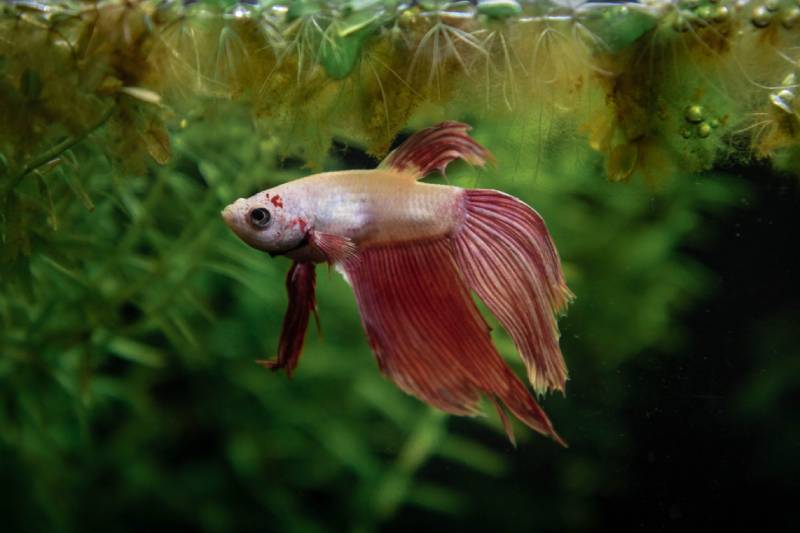
9. Dalmatian
Dalmatian Bettas are super rare and interesting to look at. These Bettas will have a main body coloration with uneven specks and patches of color. The color combinations are usually red, white, or blue which vary in contrast.

Conclusion
Overall, Bettas can be found in many different variations, and breeders are still working hard to create new and unique Bettas. A Bettas temperament isn’t defined by its colors, fins, or pattern type. So, when kept appropriately, Bettas are rewarding nano fish that are naturally curious and explorative.
It can be difficult to find some of the rarer Betta fish since they aren’t really found in pet stores. If that is the case, you might need to source a Betta fish breeder that develops the specific Betta fish variation you are looking for.
Also see:
- 5 Best Filters for Betta Fish Tanks – Recommendation & Top Picks
- 8 Best Betta Fish Foods (Freeze-Dried & Pellets) – Reviews & Top Picks
Featured Image Credit: Mr.Soonthorn Thonglor, Shutterstock
